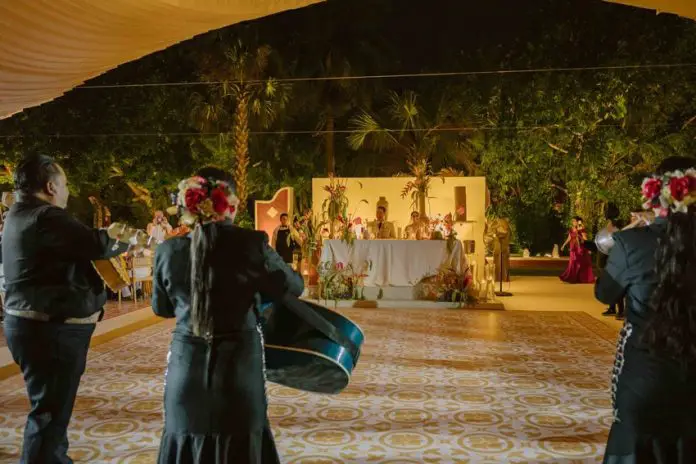One of the many pleasures of traveling or living in Mexico as a foreigner is finding surprises in the customs that are different from traditions back home, as anything from a trip to the supermarket, to turning on the TV, to getting stung by a scorpion can be a charming or sometimes painful reminder of. These differences extend to one of life’s great rituals: the wedding. As a native of the United States, I recently married a Mexican here in Mexico and have some insights to share with readers.
Early in the planning stages of the wedding, it became apparent things would be done a bit differently compared to my experiences with weddings in the U.S. When giving us a list of possible haciendas to be used as a venue, our wedding planners — the fantastic team at Tàcito — explained to us regretfully that one of the venues had a closing hour of 2 a.m.. This was a complete non-starter, and was quickly checked off our list, because, in the words of my in-laws: “who has ever heard of a wedding ending at 2 a.m.?”

Once we chose the venue, the lovely Hacienda San Diego Cutz, we met with the caterers, and set about creating a meal plan that included food to be served during the cocktail reception, dinner, dessert, followed by trays of sliders, pizza and hotdogs for the revelers to be served at 1 a.m., followed by yet another course: 3 a.m. cochinita pibil tortas to cap off the night.
For wedding attire, as the groom, I had more freedom than at a formal wedding in the U.S., where black suits and ties are standard. My choices ended up reflecting the need to handle the brutal Mérida heat: a beige linen three piece suit to be worn during the ceremony and dinner and a traditional guayabera I switched into when the party began. Nevertheless, I still suffered, and lost an estimated 15 pounds of sweat throughout the course of the day.
One of my favorite Mexican traditions we included was the addition of the tornaboda, or afterparty, held the day after the wedding. For this, we rented a large house in the countryside, ate tacos, swam in the pool and even had a mechanical bull that was a hit with the kids. The tornaboda gave us a much-needed chance to reconnect with the guests and decompress after a hectic wedding day.
For an expert perspective, I sought the insights of Kenya Díaz, part of the Tácito wedding planning team, who explained some key cultural differences. “Mexican weddings are centered around a long celebration,” she told me. “it’s what everyone looks forward to. Whereas American guests tend to anticipate things like the cocktail hour, speeches, and cake-cutting.”

“Mexicans expect the dinner to be short, with the focus on the party,” Kenya says. “Music is another point of difference. It’s a challenge to find a DJ who can keep both Americans and Mexicans dancing throughout the night. That’s why we encourage couples to share playlists of songs that are important to their guests.”
I asked Kenya about some of the more memorable moments blending both cultures. “Speeches by friends or godparents aren’t traditional at Mexican weddings,” she shared, “but one couple — Mexican bride, American groom — asked their friends to prepare funny speeches. The result? A choreographed rap detailing the bride’s most embarrassing moments, complete with a catchy chorus. We still laugh about it today and sing the chorus whenever we reminisce!”
Kenya also shared advice for Americans planning a wedding in Mexico: “Mexicans are naturally welcoming, and we make an effort to include foreign guests and show them what a Mexican wedding is like. Arriving with a party spirit is the best approach for international guests. Learning a few key Spanish phrases will be greatly appreciated. For the couple, incorporating local food into the menu and mixing locals and foreigners at the tables helps make the event a true blend of cultures, where everyone is interacting and having fun together.”
There are a few concepts that Mexican weddings have borrowed from U.S. nuptials. I was amused to hear phrases in English peppered into the wedding planning meetings, such as that special morning ritual known in both languages as the bride’s “getting-ready.” During the planning, we were frequently asked if something was a ”nice to have”” or a “need to have.” The term “bridezilla” exists in both languages, though, of course, it was never spoken during our planning process or on the wedding day — certainly not by me, and definitely never louder than a whisper.
Overall, our blended wedding in Yucatán was a roaring success, with both locals and foreign guests delighted by everything from the food to the decor to the wild partying through the night. The one place where the cultural differences were most noticeable was on the dance floor: on the Mexican side, everyone from toddlers and to grandmothers danced with rhythm and grace. For the gringos… well, let’s say that our talents shone in other ways, as we impressed everyone with our capacity to consume prodigious amounts of food and mezcal.
Stewart Merritt is a professor and freelance writer based in Mérida. A native of California, he has been visiting Mexico his entire life, especially the Pacific coast, where he likes to surf. This summer he will marry his Yucatecan fiancé.
